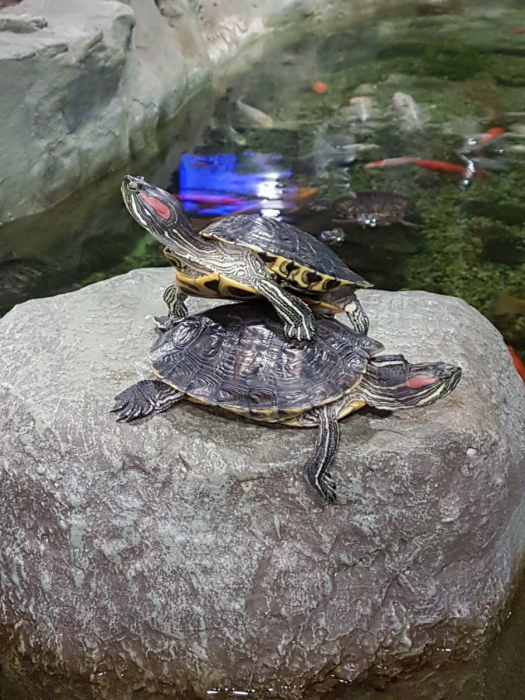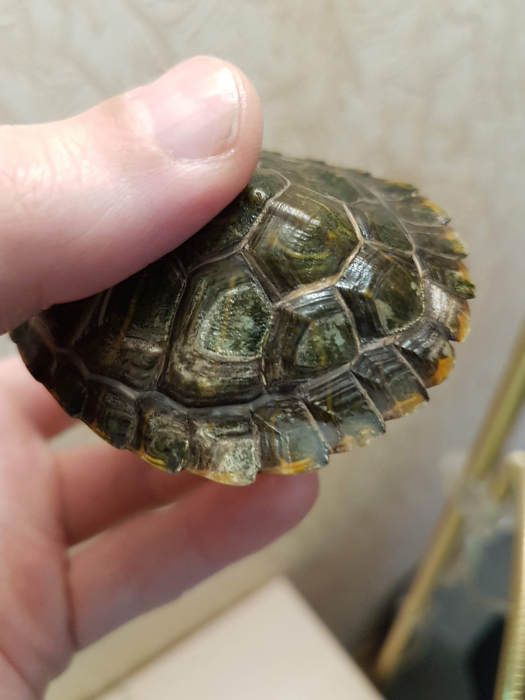Diseases of the shell of a rubella tortoise are quite common, they can be divided into 2 main groups for reasons of occurrence, although some pathologies may have a mixed etiology:
- Mycoses (fungal diseases) of the skin and the shell can be both primary (due to improper contents) and secondary (due to bacteria or viruses, as well as prolonged use of antibiotics or antiviral drugs, due to the presence of parasites in the body and even because of stress ) And also arise in cases where the turtle does not have the ability to dry out and is constantly in the water.
- Bacterial infections develop due to microorganisms that penetrate skin lesions. This happens when the pet is allowed to walk around the apartment, and allow it to stay on land for a long time, as a result of which the skin dry out and cracks appear on them.
The treatment regimen and type of drugs used depend on the type of disease. The signs of various skin diseases and the features of their therapy are described in detail below.
Material Content:
Swelling, pimples and pimples on the limbs

Similar symptoms indicate the presence of a bacterial infection. The course of Baytril or Marfloxin is shown, as well as a bath with Betadine. The disinfecting solution should be poured into a small basin so that the water becomes yellowish, and put the reptile there for half an hour. The course of therapy is 2 weeks.
Redness of large areas of the skin, detachment of the carapace of the shell
These symptoms indicate that the disease has a fungal origin.White spots on the shell of a red-eared turtle can also be a sign of mycosis, but you need to make sure that it is not plaque from water.
The treatment regimen is as follows:
- Regular disinfection of water in the aquarium with methylene blue (1-2 crystals) or similar means for a month. How often you need to make the drug is prescribed in the attached instructions. As a rule, this is done once 5 days, while half the water is replaced.
- Bathing in a solution of Antipara (1 ml of the product in 10 liters of water) for an hour. The course is 2-3 weeks. Multiplicity of procedures - daily or every other day, depending on the recommendation of the veterinarian.
- With severe reddening of the skin and if the shell of a red-eared turtle peels off, Betadine baths are shown every day for 2 weeks (dilute the preparation according to the instructions to a yellowish color). The duration of the procedure is 30-40 minutes.
- Treatment of the affected areas with antifungal ointments (Nizoral, Clotrimazole) in the evenings, while at night the reptile must be left in a container without water. The treatment lasts 2 weeks.
- Sessions of ultraviolet radiation and vitamin therapy (preparations are selected by a specialist).
In order to prevent or as an auxiliary measure for the treatment of fungus in the Red-eared Turtle, oak bark can be used. It will need to brew, like tea, in a ratio of about 1 tbsp. l 250 ml of water, insist 3-4 hours, and then pour into the aquarium.
Ulcerous lesions of the plastron and skin
Such symptoms occur when the disease has a fungal or bacterial nature. In the first case, you will need to add methylene blue to the aquarium, daily do baths with Betadine for 40 minutes. Then take out the reptile and treat the limbs, neck and carapace with Baneocin and Lamisil, mixed in a 1: 1 ratio. Lamisil can be replaced with a cheaper analogue - Terbinafine. Or use Triderm ointment instead. After that, you need to keep the red-eared turtle dry for an hour, and then return it to the aquarium. The course of therapy is 10 days.
If the cause of the problem is a bacterial infection, injections of Baytril or Marfloxin 2% are indicated (these are antibiotics of the fluoroquinolone group for veterinary use). The affected areas should be lubricated with Baneocin, and then keep the animal on land for at least 15 minutes. The duration of treatment and dosage of drugs is determined by a specialist.
The turtle has a soft shell

This is a symptom of rickets, caused by hypovitaminosis and a lack of UV light. But in some cases, there may be a fungal infection. It is necessary to show the animal to a herpetologist or a general veterinarian.
Peeling and peeling of the skin
A condition accompanied by such symptoms cannot be classified as fungal diseases or bacterial infections, therefore, special treatment is not required. It is only necessary to regularly clean peeled skin with a sponge and provide the reptile with the opportunity to be in the water or dry out when it is needed. You can make 2 injections with the vitamin drug Eleovit with an interval of 14 days.
Shell Necrosis
This violation is manifested by foci of erosion, more often in the posterior and lateral sections of the carapace. Lesions are covered with a crust of brown or gray. In this case, it is urgent to show the red-eared turtle to a specialist, since the disease is very serious.
Antifungal ointments, usually Nizoral, compresses with chlorhexidine or miramistin, antibiotics and vitamins are prescribed as treatment. When the carapace of the carapace is bleeding, daily injections of Dicinon (dose - 0.5 ml / 1 kg) and ascorbic acid are additionally used. The duration of therapy is established by the veterinarian, and also gives additional recommendations on the maintenance of the animal during the treatment period.












